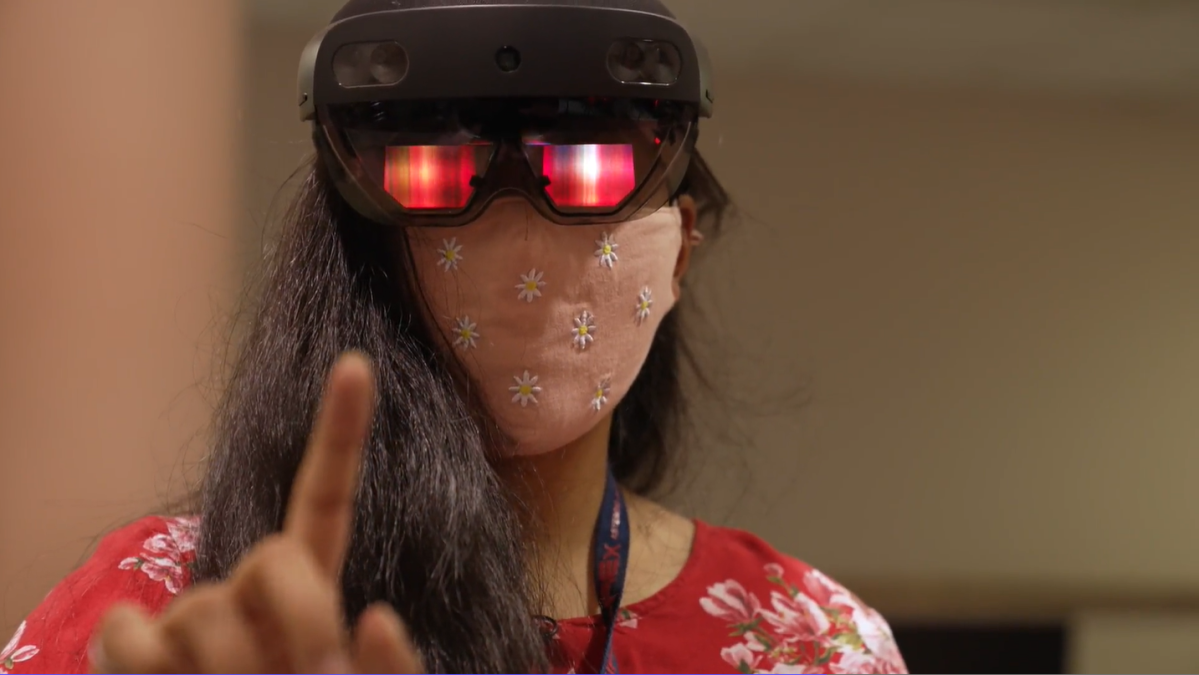

By
Jasmine Pazzano &
Jeff Semple
Global News
Published October 23, 2021
8 min read

Jessa Marie Zabala looks across the room through dark lenses and waves at her coworker, Susan Choi, who enters their meeting appearing as a floating purple astronaut’s helmet.
“Hey Susan,” Zabala says.
Two isolated hands wave underneath Choi’s head. A name tag underneath her helmet says “Susan.”
The engineers with Canadian aerospace company MDA Ltd. are not in the same province, let alone the same room — Choi, 31, is based in Montreal, while Zabala, 26, lives in Toronto.
They communicate with each other using augmented reality lenses. These project holograms and put them in a virtual room where their colleagues appear as avatars right next to them on a simulated space station. The company used the technology out of necessity after the COVID-19 pandemic pushed MDA to send its staff home in 2020, but it’s now a mainstay in their jobs.
“You roll out of bed and you put on a headset instead of getting into your car and driving to work,” Zabala says, laughing.
As companies grapple with what a mid- and post-pandemic future of work looks like for different teams — whether that means exploring new innovations, returning to an office space or, as Shopify announced last year, ending “office centricity” — a workplace culture consultant says employers need to ditch the idea there’s a one-size-fits-all solution.
“We need people to be creative because they have to solve problems that they’ve never had to solve before,” Andrew Au says.
Thinking differently
Au is co-founder of an agency, Intercept, that helps companies rethink the way they work. “Since the pandemic, we’ve never been busier as a firm.”
Part of his job is helping employers attract and keep new talent, and when he thought about what would work for his 30-person company, he looked outside.
Before anyone had even uttered the words “novel coronavirus,” Au purchased what his team has nicknamed the “Intercept Cottage” — an all-season property just over an hour’s drive north of his Toronto office. It was meant to be a getaway space for his team and their families to reserve for free, but the pandemic has turned it into what he says has become a life-changing resource where his staff work, relax and recharge outside of their homes, where they’ve been adjusting to working from for more than a year and a half.
They’re among the third of Canadian employees who spent most of their work hours from home at the beginning of this year compared with not even five per cent of working Canadians in 2016.
Au, who spends time at the cottage with his wife and two kids, says as he looks out at Lake Simcoe, “You could have your laptop and could be sitting there at the beach club.
“You come here and you just feel relaxed. The pace slows right down.”
He’s now looking into buying several more properties at the same Innisfil, Ont., resort as he grows his team.
This one-time investment continues to benefit the company in terms of value of assets, he says, but “more importantly … you’re giving employees a better experience.”
A global survey recently found that most workers want to continue to have flexible, remote work options — whether that means working from a lakeside cottage or in a virtual space station.
MDA’s team has trained astronauts and flight controllers for 40 years to operate Canadarms, a series of robotic arms used on space shuttle missions and the International Space Station.
The team is now doing this remotely by wearing a Microsoft technology called HoloLens, transporting them into a place where their colleagues — from Canada to Houston — can interact with holographic versions of the robotic arms in real-time (they can use their hands to “grab” onto different parts) and explore the inner mechanisms of the space technology. Zabala likens this experience to being a mechanic who can see underneath the hood of a car, even if it’s in another country.
The technology has now become part of their everyday jobs, and as MDA eases employees back to its offices part-time, they continue to use the lenses.
Similarly, people in other industries have recently adopted the same technology, from the team at Canada’s oldest candy company, Ganong, to doctors around the world assisting virtually during surgery.
But as we find more creative ways to work apart from one another, there is another trend emerging: most people are craving more face-to-face interactions.
Co-working spaces: the workplaces of the future
William Mansur has worked remotely for years — even before the pandemic, his company had offered flexible work options for some of its departments, including his.
But his employer shuttered its locations last year indefinitely, and he suddenly faced the problem of having no office at all.
Mansur sought out a sense of community, and his solution was joining a downtown Toronto co-working space for $300 a month.
The 27-year-old computer programmer’s job has enabled him to travel and live around the world — he’s currently living on an eight-metre-long sailboat parked among dozens of others at a Toronto marina. He says he’s drawn to boating for the same reason he joined the co-working space.
“You’re immersed in many different communities,” he says while sitting in a chair at the co-working space, which has rows of desks, a kitchen, and private rooms for any of its members to use. “You can meet some really interesting people.”
He compared working there to being in a library as a student, where everyone is focused on something different.
Global News spoke with co-working spaces across Canada, all of which say that as vaccination rates have climbed past 70 per cent nationally, they’re seeing a spike in demand for memberships from both individuals and corporations looking to offer more flexible workspaces for employees.
“We’re seeing renewed interest in these co-working spaces,” Au says. “People don’t feel so isolated and so remote. They can feed off other people’s energy.”
Before the pandemic, Meredith Garritsen started her own Vancouver co-working space, Hervana, with the goal of providing a safe and inclusive realm for women and people who are nonbinary. But what she built for others eventually became, in her words, her own “safety net.”
Last year brought new hurdles in her personal life — her marriage fell apart and her mother was diagnosed with dementia — and closing the physical Hervana space in 2020 forced her to move aspects of her business online. She started hosting regular meetings for Hervana members to chat virtually in lieu of working next to each other.
“When things started to fall apart at home for me, I already had this network that I was able to turn to,” she says.
Hervana has reopened its doors as B.C. coronavirus cases have gone down and restrictions have loosened, but she says the pandemic has revealed the power of having a space to work away from home and personal lives.
“Physically being in another environment allows them to have a little bit more mental capacity to address their work.”
Re-envisioning a traditional office environment
As many Canadian companies reopen their offices, people will likely see tweaks to the spaces they remember from early 2020 before heading home.
“Employees are more aware of risk and exposure,” Au says. “Going forward, they expect to see sanitization procedures. They expect to see healthy and safe environments.”
At the Brampton, Ont., headquarters of MDA, each person who walks into the building has to pass through a temperature scanner featuring a thermal camera. Employees have to wear masks in common areas.
Other companies tell Global News they’ve implemented coronavirus detection systems and traffic flow patterns using foot-shaped stickers on the ground.
Microbial infections expert Dr. Dasantila Golemi-Kotra says that while some of these measures can be effective, the best protection is to get vaccinated.
“You have personally taken the steps to protect yourself,” she says. “You get the vaccine (and) if you are infected with the virus, the chances for you to develop the disease are very low.”
MDA is requiring all employees to be fully vaccinated by Nov. 30. Until then, they offer COVID-19 rapid testing.
Dr. Golemi-Kotra recommends that companies invest in solid air ventilation systems to prevent the spread of COVID-19 in office spaces.
The companies of the future
Even if their employers have made their offices safer places to be, people resist reverting back to their pre-pandemic routines — 35 per cent of Canadians polled in a 2021 survey say they would quit their jobs if their employers had them work on-site.
Au says companies have to combat attrition by pivoting their focus from customer experience to employee experience. He advises employers to ask themselves what they stand for and what they need to do to better personalize their employees’ career trajectories.
“Work has changed permanently,” Au says. “I think that some form of hybrid will be the norm and hybrid will mean different things to different employers.”
“If companies don’t change, they will lose people, their most valuable asset.”
Mansur says introducing different industries to remote work was always inevitable, but it has definitely pushed that to the present.
When asked what the future of work looks like for him, Mansur says, “I don’t know, but hopefully it’s very exciting … and hopefully there’s something undiscovered there that I will discover.”
Ultimately, the pandemic has put remote work at “centre stage,” as Mansur puts it, and that has opened up a colourful spectrum of possibilities.
“Whatever flavour of working you like is now more available.”
—
See this and other original stories about our world on The New Reality airing Saturday nights on Global TV and online.


Comments